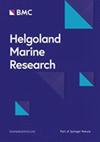北弗里斯兰瓦登海日本沙潮上生、死有孔虫组合:分布格局及控制因素
4区 地球科学
Q2 Agricultural and Biological Sciences
引用次数: 2
摘要
潮上沙对德国瓦登海的海岸防御至关重要。由于远离大陆海岸,受人类活动的影响较其他地区小,一般禁止进行旅游和商业活动。因此,潮上沙具有很高的生态价值。然而,对这些沙地上微生物的区系清查和分布格局研究甚少。因此,从日本的潮上沙到哈利胡格的样带研究了活的和死的有孔虫组合的组成。两个组合均以钙质有孔虫为主,其中以batava氨虫最为丰富。自恋Elphidium selseyense和williamsoni Elphidium williamsoni在活组合中也很常见,但williamsoni在死组合中相对较少。巴塔瓦氨和自恋Elphidium selseyense在生活组合中所占的比例较高,这是由于物种之间的繁殖季节不同。当巴塔瓦氨和selseyense Elphidium刚刚结束它们的繁殖周期时,williamsoni Elphidium才刚刚开始。不同物种的大小分布模式也证实了这一点。在死亡组合中发现了20种未在活组合中发现的物种,其中一些是在较老的沉积物中重新加工的(例如,buella frigida),一些是通过北海其他地区的潮汐流运输的(例如,Jadammina macrescens)。活着的有孔虫动物群描绘了开放的北海和大陆之间的密切联系。揭示远隔种群间交换的主要物种为德国海蝇、巴塔瓦氨和不同种类的Elphidium。所有这些物种都有机会主义行为,能够生活在各种不同的环境中;因此,它们可以很好地应对不断变化的环境条件。日本底栖有孔虫群落表明,潮汐和海流的运输机制对该遗址的动物组成具有重要的生态作用。本文章由计算机程序翻译,如有差异,请以英文原文为准。
Living and dead foraminiferal assemblage from the supratidal sand Japsand, North Frisian Wadden Sea: distributional patterns and controlling factors
Supratidal sands are vitally important for coastal defence in the German Wadden Sea. They are less affected by human activities than other areas as they are located far off the mainland shore, touristical and commercial activities are generally prohibited. Therefore, supratidal sands are of high ecological interest. Nevertheless, the faunal inventory and distribution pattern of microorganisms on these sands were studied very little. The composition of living and dead foraminiferal assemblages was therefore investigated along a transect from the supratidal sand Japsand up to Hallig Hooge. Both assemblages were dominated by calcareous foraminifera of which Ammonia batava was the most abundant species. Elphidium selseyense and Elphidium williamsoni were also common in the living assemblage, but Elphidium williamsoni was comparably rare in the dead assemblage. The high proportions of Ammonia batava and Elphidium selseyense in the living assemblage arose from the reproduction season that differed between species. While Ammonia batava and Elphidium selseyense just finished their reproductive cycles, Elphidium williamsoni was just about to start. This was also confirmed by the size distribution patterns of the different species. The dead assemblage revealed 20 species that were not found in the living assemblage of which some were reworked from older sediments (e.g., Bucella frigida) and some were transported via tidal currents from other areas in the North Sea (e.g., Jadammina macrescens). The living foraminiferal faunas depicted close linkages between the open North Sea and the mainland. Key species revealing exchange between distant populations were Haynesina germanica, Ammonia batava and different Elphidium species. All these species share an opportunistic behaviour and are able to inhabit a variety of different environments; hence, they well may cope with changing environmental conditions. The benthic foraminiferal association from Japsand revealed that transport mechanisms via tides and currents play a major ecological role and strongly influence the faunal composition at this site.
求助全文
通过发布文献求助,成功后即可免费获取论文全文。
去求助
来源期刊

Helgoland Marine Research
地学-海洋学
自引率
0.00%
发文量
0
审稿时长
6-12 weeks
期刊介绍:
Helgoland Marine Research is an open access, peer reviewed journal, publishing original research as well as reviews on all aspects of marine and brackish water ecosystems, with a focus on how organisms survive in, and interact with, their environment.
The aim of Helgoland Marine Research is to publish work with a regional focus, but with clear global implications, or vice versa; research with global emphasis and regional ramifications. We are particularly interested in contributions that further our general understanding of how marine ecosystems work, and that concentrate on species’ interactions.
 求助内容:
求助内容: 应助结果提醒方式:
应助结果提醒方式:


